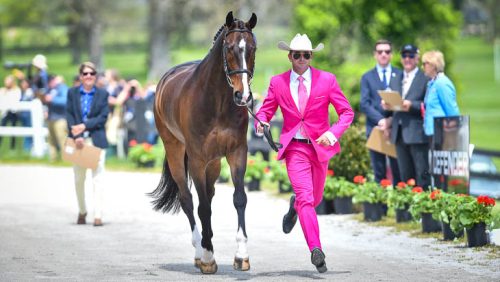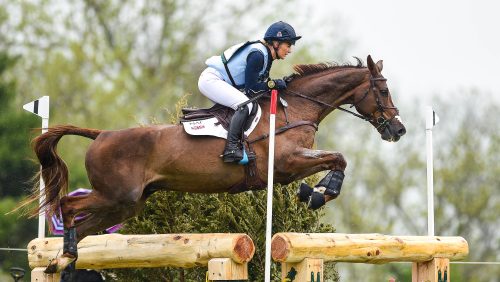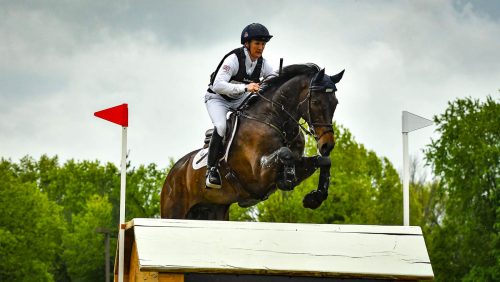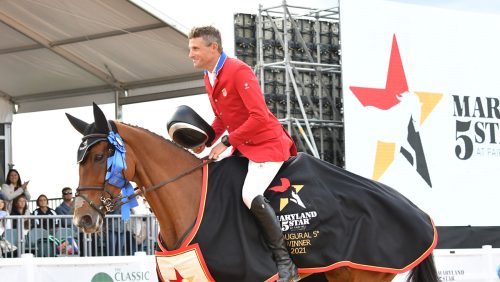Off-the-track Thoroughbreds have skyrocketed in popularity over the past few years, and a program held in conjunction with the Rolex Kentucky CCI**** set out with the mission to prove the versatility and adaptability of Thoroughbreds in a second—or third—career.
West Wind Farm in Lexington, Ky., hosted Thoroughbreds For All on April 26 to showcase some of the horses available for adoption through the New Vocations Racehorse Adoption Program and the Retired Racehorse Training Project as well as educate spectators about race horses coming off the track.
Attendance topped 500 this year, up from 300 spectators in 2012.
“There was definitely a huge amount of interest this year, and it appears that we had a good number of people who came back from last year,” said Anna Ford, program director of New Vocations. “I think the great turnout shows that the general equestrian public is really interested in learning more about retired Thoroughbred race horses.”
Guests saw Chris McCarron, veteran jockey; winner of a 1974 and 1980 Eclipse Award; and founder of the North American Racing Academy, the first professional jockey school in the United States. McCarron mounted Bilan, a horse from the New Vocations program he’d never seen before, and performed what he jokingly referred to as “jockey dressage.”
Although Bilan was at first antsy and difficult in front of the big crowd, McCarron explained the first thing he aims to achieve when he gets on a horse is cooperation, which he does by “creating comfort.”
By showing Bilan that he was confident, and therefore in control of the situation, McCarron soon had the chestnut going nicely and even performed a few flying lead changes in each direction.
Choosing A Winner
ADVERTISEMENT
As part of Thoroughbreds For All, advanced eventer Phillip Dutton and veterinarian Kevin Keane, DVM, evaluated several horses recently retired from racing as potential event horses. While Dutton focused on way of going and particular elements of conformation, Keane explained from a medical standpoint why he would recommend certain horses over others.
Keane also discussed each horse’s record on the track and what that might mean, although he readily admitted that more research was needed to confirm any of his assumptions. For example, El Paso, a 6-year-old dark bay gelding by El Corredor, spent four years training at the track, but he never raced. Keane wondered if an underlying issue kept him out of the starting gate.
In contrast, Come On Moe, a 15-year-old bay gelding by Eskimo, raced until 2002 and then became a schoolmaster at the North American Racing Academy with McCarron. Dutton pointed out his good shoulder and neck, but that with a slightly longer back, collecting and moving well might be difficult given his conformation.
Keane didn’t mind Moe’s longer back, and he noted a study of jumpers that showed horses with a longer back can stretch out and have a lot of scope. Moe’s calm demeanor and penchant for treats made him a crowd favorite, and he was adopted a few days after the event.
Keane, a student of Dutton’s as well as his veterinarian, said, “I’ll take a horse with a great mind and trainability over great talent.”
Get Them Under Saddle
After evaluating several horses, three OTTBs in the New Vocations program were chosen for an under-saddle evaluation.
Eventers Eric Dierks, Daniel Clasing and Tracy Bienneman hopped on Shiny Pemmy, Moe and Strasbourg, respectively, and started by just walking around the arena. Dutton encouraged them to let the horses find their own gaits at the walk, trot and canter without too much interference from the riders.
ADVERTISEMENT
Strasbourg, a 7-year-old chestnut gelding by Friends Lake, was moving unevenly with his hind legs, prompting Keane to suggest looking into it further to ensure there wasn’t an underlying issue.
After going at all three gaits in both directions, the three horses walked, then trotted over a ground pole. They then progressed to a cross-rail, and finally a small vertical and a small oxer, both of which Dutton raised bit by bit as the horses became more comfortable.
Each horse had both positive and negative attributes, but all improved and learned during the pseudo-lesson.
The horses were certainly less than perfect doing the exercise, but Dutton and Keane both emphasized watching each horse’s reaction, way of going, and learning from mistakes.
While Dierks’ ride, Pemmy, was a good, forward-thinking horse, Dutton noted she was a little quick in her jump and a little tight. However, she impressed the crowd enough to get adopted that evening by a family who was already approved through the application process.
When Clasing’s horse, Moe, tried to run out and took down the standard on their first time cantering toward the oxer, Dutton pointed out, “That’s the downside of cantering—you lose a little bit of control.”
The evening ended with a good reminder of what an OTTB can accomplish, as a few competitors from the Rolex Kentucky CCI**** spoke to the crowd about their OTTBs. Then, local Lexington, Ky., eventers Dorothy Crowell and Cathy Wieschoff put their own OTTBs, Hennessy and Ready For April, through their paces on the flat and over some jumps to close out the event.














